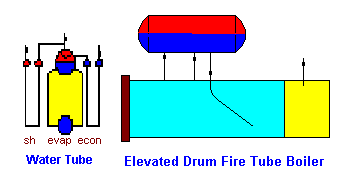Water Tube Boilers
 Suitable
for high steam pressure (above 500 psig) and temperature(to 1000 F) and
large capacities exceeding millions of lb/h of steam. Suitable
for high steam pressure (above 500 psig) and temperature(to 1000 F) and
large capacities exceeding millions of lb/h of steam.
 Extended
surfaces can be used in waste heat applications to make the boilers compact
if the gas stream is clean. Extended
surfaces can be used in waste heat applications to make the boilers compact
if the gas stream is clean.
 Various
types of fuels can be fired with ease including solid,liquid and gaseous.
The water cooled membrane wall construction makes an excellent furnace. Various
types of fuels can be fired with ease including solid,liquid and gaseous.
The water cooled membrane wall construction makes an excellent furnace.
 If
the gas stream is dirty(as in MSW applications)provision can be made for
cleaning using soot blowers or rapping mechanisms.Wide spaced tubes can
be used at the gas inlet to minimize bridging of slag deposits and tube
spacing can be decreased as the gas is cooled.This flexibility does not
exist in fire tube designs. If
the gas stream is dirty(as in MSW applications)provision can be made for
cleaning using soot blowers or rapping mechanisms.Wide spaced tubes can
be used at the gas inlet to minimize bridging of slag deposits and tube
spacing can be decreased as the gas is cooled.This flexibility does not
exist in fire tube designs.
 Superheaters
if used can be located at the optimum gas temperature region shielded by
any number of screen tubes.In fire tube boiler the choice is at the gas
inlet or exit. Superheaters
if used can be located at the optimum gas temperature region shielded by
any number of screen tubes.In fire tube boiler the choice is at the gas
inlet or exit.
 Due
to low water volume,the startup time is lesser and response to load changes
is faster compared to fire tube boilers. Due
to low water volume,the startup time is lesser and response to load changes
is faster compared to fire tube boilers.
 If
the gas pressure is high,say above 5 psig,the shell/casing design gets
complicated and expensive though it can be done. If
the gas pressure is high,say above 5 psig,the shell/casing design gets
complicated and expensive though it can be done.
 Due
to higher heat transfer coefficients surface area required is lesser and
hence gas pressure drop is also lower. Due
to higher heat transfer coefficients surface area required is lesser and
hence gas pressure drop is also lower.
 For
multiple pressure designs as in gas turbine exhaust applications,water
tube is the only choice. For
multiple pressure designs as in gas turbine exhaust applications,water
tube is the only choice.
|
Fire Tube Boilers
 Ideal
for low pressure steam. As seen above in the table,the tube thickness increases
significantly at high pressures if the pressure is applied externally.The
pressure can be nearly twice in water tube designs for the same tube thickness. Ideal
for low pressure steam. As seen above in the table,the tube thickness increases
significantly at high pressures if the pressure is applied externally.The
pressure can be nearly twice in water tube designs for the same tube thickness.
 Suitable
for high pressures as gas is contained inside tubes.Hence you see more
of them in hydrogen,ammonia plants,where the gas pressures can be in the
range of 500 to 3000 psig. Suitable
for high pressures as gas is contained inside tubes.Hence you see more
of them in hydrogen,ammonia plants,where the gas pressures can be in the
range of 500 to 3000 psig.
 When
a large duty has to be transferred at a low log-mean-temperature-difference
as in gas turbine exhaust HRSG applications,surface area required gets
enormous and very long tubes are required,adding to the gas pressure drop.The
shell diameter becomes huge;hence unsuitable except in very small
gas turbine Hrsgs generating low pressure saturated steam. When
a large duty has to be transferred at a low log-mean-temperature-difference
as in gas turbine exhaust HRSG applications,surface area required gets
enormous and very long tubes are required,adding to the gas pressure drop.The
shell diameter becomes huge;hence unsuitable except in very small
gas turbine Hrsgs generating low pressure saturated steam.
 Economizer
and superheater can be added but the location for superheater is either
at the gas inlet or exit,making it difficult to come up with a good design
if corrosive conditions are present. Economizer
and superheater can be added but the location for superheater is either
at the gas inlet or exit,making it difficult to come up with a good design
if corrosive conditions are present.
 If
slagging is a concern,then fire tube designs are generally not suitable
as the tube inlet can be plastered with slag. The gas inlet temperature
has to be reduced through flue gas recirculation or the gas can be cooled
in an external water cooled furnace,making it a difficult design. If
slagging is a concern,then fire tube designs are generally not suitable
as the tube inlet can be plastered with slag. The gas inlet temperature
has to be reduced through flue gas recirculation or the gas can be cooled
in an external water cooled furnace,making it a difficult design.
 Cleaning
the tubes is easier if there is no slagging.In the case of water
tube,the deposits can be formed on both the tubes and the casing,while
in the fire tube it is only inside the tubes. Cleaning
the tubes is easier if there is no slagging.In the case of water
tube,the deposits can be formed on both the tubes and the casing,while
in the fire tube it is only inside the tubes.
 A
separate steam drum with internals is required if good steam purity(0.05
to 1 ppm) has to be achieved. A
separate steam drum with internals is required if good steam purity(0.05
to 1 ppm) has to be achieved. |

![]()